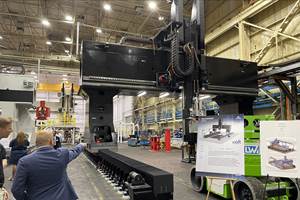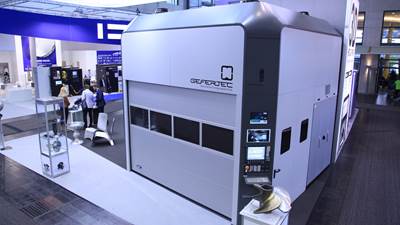Aerospace suppliers are faced with relentless price pressures and increasing demand for lightweight components, which means they must make significant strides to drive down costs and meet delivery times. The need for increasingly complex components and systems also requires significant investment in new engineering and manufacturing capabilities to drive innovation while trying to drive down the cost per unit.
To realize cost savings in its manufacturing processes Aircraft Philipp turned to additive manufacturing (AM) technologies. A medium-sized group company with over 50 years of experience in manufacturing ready-to-install metal components and assemblies for the aviation and aerospace industry, Aircraft Philipp has locations in Germany, Austria and partnerships in Israel and India. The company specializes in the manufacture of large parts up to 7 meters in length using typical aerospace materials such as aluminum and titanium. This specialty means keeping a high stock of raw materials, which needs to be pre-financed, as Heinz Baehr, member of the executive board, Aircraft Philipp Group in Übersee, Germany, explains.
Reducing Material Inputs
“We need several thousands of tons of aluminum and several hundred tons of titanium per year. One kilogram of titanium costs about 50 euros, so our investments in raw material titanium amount to a whopping two-digit million euros per year,” he says. “Following several machining processes that include cutting, turning, milling and drilling, up to 90% of the original titanium is left over as waste chips. These chips are contaminated with coolants or are mixed with foreign substances. So far, theses have not been able to be recycled at a reasonable cost.”
To gage the amount of waste in the process of making parts, aerospace engineers calculate the ratio between the weight of the material used to make a component and the weight of the component itself—the “buy-to-fly” ratio. The ideal buy-to-fly ratio would be “1,” indicating no loss of material during manufacturing. For conventional metal manufacturing like milling, the buy-to-fly ratio is often higher than 10, which means enormous costs.
Another challenge in the machining of titanium is achieving fast metal removal rates with reasonable tool life. While recent advances in machine tool and tooling technology have led to shorter cycle times, increased tool life and higher shop productivity, Baehr is constantly on the lookout for new technologies and alternatives to conventional machining technologies to reduce cycle times and costs.
As a result, the company invested in additive manufacturing technologies four years ago and can meanwhile build on its AM experience using SLM powder bed fusion (on the EOS M290 platform) at its Salzburg, Austria, facilities. Furthermore, Aircraft Philipp initiated a joint research project “Regulus,” funded by the German Federal Ministry of Economic Affairs and Energy, to develop and implement a process chain for the resource-saving production of large structures made of titanium materials. The central element of the solution approach is wire arc additive manufacturing of raw contours in order to reduce the degree of machining. This is intended to reduce the current use of materials by 90%.
“We buy raw material to make it fly; the less material remains on the ground the better.” Heinz Baehr, member of the executive board, Aircraft Philipp Group in Übersee, Germany
“The intention is to have the arc-based AM process certified for the aviation industry at some stage. Currently we are in the certification process,” Baehr explains. “The aerospace industry needs proof of 100% reproducibility, and since the near-net shape parts produced by arc-based welding exhibit different material structures and properties, it is not certified yet. That’s what we are working on. The technology is currently at a Technology Readiness Level (TRL) 3, which means at a stage of analytical and experimental critical function and/or characteristic proof-of-concept.”
The required analytical and laboratory studies are carried out at Regulus project partners TU München and FAU Erlangen to see if the technology is viable and ready to proceed further through the development process.
While Aircraft Philipp initially intended to develop its own machine together with welding specialist company Fronius and has been working with the latter's wire arc additive manufacturing (WAAM) technology for a while to manufacture titanium raw parts, the company recently decided to invest in a Gefertec arc605 3DMP machine. The machine has been installed at the company’s Übersee premises in Bavaria.
After intensive research and evaluation Baehr and his team decided that the Gefertec system was the most suitable and cost-efficient machine for their needs. “Gefertec uses the same technology as we already have in-house with our WAAM technology. In contrast to some other AM processes such as electron beam melting (EBM), arc welding technology is a robust and simple technology that allows the creation of near-net shape components with high buildup rates. There is no limit to part size and, in contrast to electron beam welding, there is no need for a vacuum chamber."
Building Near-Net Shape Parts to Reduce the Buy-To-Fly Ratio
The arc605 five-axis metal 3D printer allows for the production of metal components ranging to 0.8 square meters and 500 kg, ideal for Aircraft Philipp's product range. Combined with Gefertec’s experience in welding, Baehr aims to take the technology to the next level and have it certified for aerospace applications.
Gefertec calls its arc welding technology 3DMP (3D metal print). The metal wire is melted and applied to a substrate during the printing process, using arc welding technology in conjunction with a linear axis system and an optional rotary swivel unit. Using this principle, welding passes are made parallel to, as well as on top of, each other, thus allowing the component to be generated in surface and height.
In comparison to other additive manufacturing methods, there are a multitude of norms and guidelines already available to which wire- or arc-based processes can be applied, depending on the application. The build rate varies depending on the material used, and is currently up to 600 cm3/hr. for aluminum and 450 cm3/hr. for titanium/nickel-based alloys and steel.
“The buildup rate and the massively improved buy-to-fly ratio of 2 (for a five-kilogram part we now only require 10 kilograms of raw material) allows us to economically produce large aerospace components from various materials at lower costs. We buy raw material to make it fly; the less material remains on the ground the better,” Baehr says.
Related Content
Aluminum Gets Its Own Additive Manufacturing Process
Alloy Enterprises’ selective diffusion bonding process is specifically designed for high throughput production of aluminum parts, enabling additive manufacturing to compete with casting.
Read MoreWorld’s Largest Metal 3D Printer Seen at Ingersoll Grand Opening Event
Maker of large additive and subtractive machines adds capacity in Rockford, Illinois.
Read More3D Printed Cold Plate for an Electric Race Car: The Cool Parts Show #51
An unconventional lattice design and biomimicry are key to the performance of this fluid-cooled heat exchanger for a battery-powered race car.
Read MoreVulcanForms Is Forging a New Model for Large-Scale Production (and It's More Than 3D Printing)
The MIT spinout leverages proprietary high-power laser powder bed fusion alongside machining in the context of digitized, cost-effective and “maniacally focused” production.
Read MoreRead Next
Advantages of Wire Over Powder in Additive Manufacturing
Gefertec says its wire-fed additive manufacturing systems can overcome existing process limitations of powder-fed systems.
Read MoreGE Additive Rebrands as Colibrium Additive
As part of the brand name transition, both the Concept Laser and Arcam EBM legacy brands will be retired.
Read MoreVideo: Intelligent Layering Metal 3D Printing at 3DEO
Contract manufacturer 3DEO delivers metal parts using Intelligent Layering, a binder jetting-like 3D printing process the company developed and operates internally. Here’s how it works.
Read More
_wide_wide.jpg;maxWidth=2000;quality=70)

.jpg;width=700;quality=80)
.JPG;width=860)
.jpg;width=860)
.jpg;width=860)












.png;maxWidth=300;quality=90)









